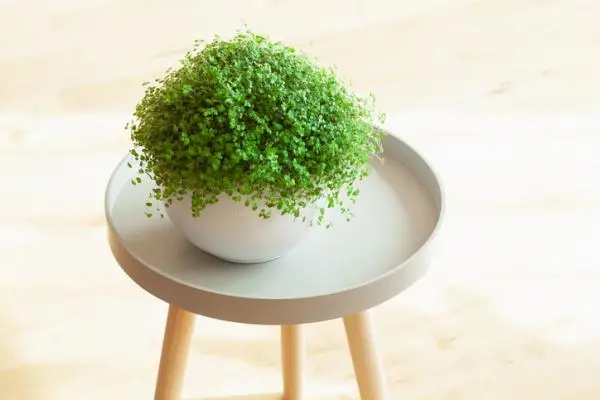Soleirolia is a genus of creeping plants that has 3 species, the most popular of which is Soleirolia soleirolii , commonly called bridal mattress, angel’s tears, mother of a thousand or bridal bed moss. It is a very useful plant for upholstering surfaces due to its rapid growth and although it is not very demanding with its care, we cannot place it anywhere.
If you want to learn how to care for a soleirolia, what its characteristics are and how to reproduce it, join us in this article where you will see a complete guide on soleirolia care .
Soleirolia characteristics
These are the main characteristics of the soleirolia plant :
- It is a small plant, with small stems that rarely exceed 10 cm in height.
- It is native to the Mediterranean area, where it grows naturally in shady and humid areas.
- Decoratively, the plant is highly appreciated for its small, bright green leaves that form very beautiful compact tapestries, recalling its appearance to that of moss. It is therefore used as an alternative to grass on occasions, although soleirolia cannot be located in areas that are going to be stepped on, since it does not support it and dies.
- Its flowers are small and very inconspicuous, so they do not have a great impact on its value as an ornamental plant.
- Its care is not difficult or too demanding, but the plant does not tolerate certain conditions that must be taken into account.

Climate for soleirolia
This creeping or upholstery plant has a mild Mediterranean climate and does not tolerate high temperatures or strong frosts. It can withstand occasional light frosts, although prolonged or intense frosts will kill the aerial part of the plant. Of course, it is most likely that it will re-sprout without problems the following spring.
Indoors, the ideal is to keep it in an area with a stable temperature above 5 ºC.
Soleirolia light and location
The bridal mattress does not tolerate direct sun exposure. Therefore, it is important to locate it in a bright place but protected from direct exposure . For example, shady or semi-shaded gardens are a very suitable option, as well as bright rooms but in which the light does not enter directly through their windows. If the soleirolia is exposed to intense sun, its leaves and stems are most likely to burn and blacken, its aerial part dying immediately, as in the case of frost.
If it is planted indoors, the plant needs pots or containers without drainage holes, which help it to maintain humidity. In the case of not having these, place a plate under the pot that accumulates water and humidity. Outdoors, remember to look for a secluded area that will not be stepped on, as it does not have the resistance of grass.

Irrigation of soleirolia
Along with its location in shade or semi-shade, watering is the most important care for this beautiful upholstery plant. The soleirolia is very demanding with the humidity and the waterings , and it is that it needs that its soil or substrate is always humid.
If you have it in a pot with drainage holes and a dish underneath, water the dish directly , letting the soil absorb the moisture naturally and allow it to reach the plant. If you have used a container without drainage, water over it without problems, trying to moisten the soil abundantly, but never water it. The plant responds much better to irrigations with water without lime.
Soil and compost from soleirolia
As its roots are very shallow, the plant is not demanding at all with the organic matter in its soil. Any loose soil or substrate that offers good drainage will suffice . You can use universal substrate and add a quarter of coarse sand to it so that the soil aerates and drains better.
Regarding the compost, it will be sufficient to apply mineral fertilizer every 15 days in the warm months , or add some worm cast to the soil in those months.

How to reproduce soleirolia
Reproducing the soleirolia is very simple thanks to its superficial root system and the rapid growth of the plant.
- Remove a section of the plant with its soil carefully, and you will see that the roots are short and take very little substrate with them. You can separate it with the same hands, trying to damage the plant very little.
- Divide the removed patch into as many fractions as you want to multiply your plant.
- Prepare small pots without drainage with properly hollowed universal substrate and with the addition of coarse sand.
- Place the separate pieces of soleirolia on the new substrate, and press it lightly on it so that the roots come into contact with their new soil.
- Store abundantly and place the containers in shade or semi-shade, where they will quickly root and begin to grow. For example, the windows of bathrooms and kitchens where the sun does not shine are a very typical location for soleirolias.
